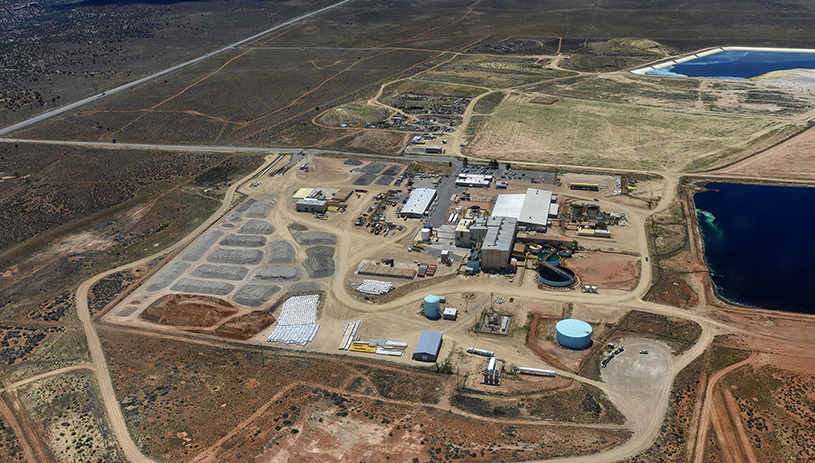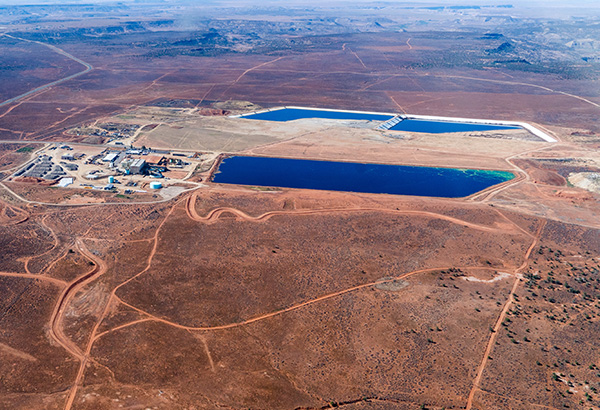FOR IMMEDIATE RELEASE
White Mesa, UT—Bills of lading recently uncovered in a shipping database reveal that Energy Fuels Resources imported more than 275,000 pounds of radioactive materials from the Japan Atomic Energy Agency. The materials appear to have been trucked to the company’s controversial White Mesa uranium mill, a mile from Bears Ears National Monument and just up the road from the Ute Mountain Ute Tribe’s White Mesa community.

The ore pad at the White Mesa Mill on May 16, 2024. The suspected Japan Atomic Energy Agency containers can be seen at the bottom center of the photo, in a vertical white column beside the bright yellow area. Photo by Tim Peterson, flown by EcoFlight.. TIM PETERSON, FLOWN BY ECOFLIGHT
The materials arrived in the port of Everett, Washington on January 16, 2024. Aerial photos taken of the mill on May 16, 2024 reveal numerous shipping containers believed to hold materials from Japan’s nuclear energy program, including uranium ores used in testing, uranium-loaded resins, filter-bed sands, and uranium-loaded carbon, which Japanese regulators view as waste.
"While the mill may extract a small amount of uranium from these materials, more than 99% of them will likely end up buried in the waste pits at the White Mesa Mill along with the more than 700 million pounds of radioactive waste already there," said Tim Peterson, cultural landscapes director for the Grand Canyon Trust. "This latest shipment from Japan shifts the burden of Japan’s radioactive legacy from Japanese citizens to the people of White Mesa."
Information about how much the Utah mill might have been paid to process and dispose of the materials has not been made public. Normally, a uranium mill would pay for uranium ore, but for decades the White Mesa Mill has instead earned millions in fees to process and discard radioactive materials from across North America and the world.
"If the mill’s operators are getting paid to receive this shipment from Japan, it’s not for processing uranium, but for disposing of waste the Japanese people don’t want near their communities," said Peterson.
This is the second time in 19 years that the Japan Atomic Energy Agency has shipped radioactive materials to White Mesa. In 2005, the agency paid the White Mesa Mill $5.8 million to unload 1 million pounds of radioactive soils.
"There’s no easy way for the public to track how much radioactive waste is being sent to the mill, where it’s coming from, and when. This should be a concern for anybody who drives along Utah’s highways," said Chaitna Sinha, staff attorney for the Grand Canyon Trust. "If the mill is going to function like a radioactive waste disposal business, it should be regulated like one, including obtaining the licenses and permits a commercial waste-disposal facility would have to secure to operate."
The Ute Mountain Ute Tribe and community members in White Mesa are concerned that the mill’s radioactive waste processing and disposal business has created a de facto radioactive waste dump in their backyard, threatening public health, water, and air quality in White Mesa. The tribe and the grassroots group, White Mesa Concerned Community, will host a spiritual walk to protest the mill on October 12, 2024.
Energy Fuels Resources is also expected to begin trucking uranium ore from its Pinyon Plain uranium mine (formerly Canyon Mine) near the Grand Canyon and the Havasupai Tribe’s sacred mountain, Red Butte, to the White Mesa Mill sometime this summer, despite opposition from the Havasupai Tribe, the Navajo Nation, and communities along the haul route.
Photos and maps
Photos with and maps with credit and caption information are available for media and educational use here.
Background
The arrival of the Japan Atomic Energy Agency waste comes nearly four years after the White Mesa Mill’s owner informed the Utah Division of Waste Management and Radiation Control that it intended to accept and process the Japanese materials. On July 28, 2020, the Utah Division of Waste Management and Radiation Control agreed that the White Mesa Mill did not need additional licensing to accept the waste. The White Mesa Mill has a long history of processing and discarding radioactive wastes from across North America and around the world, documented in the interactive story map, "Bears Ears & Radioactive Waste: The White Mesa Mill Story."


